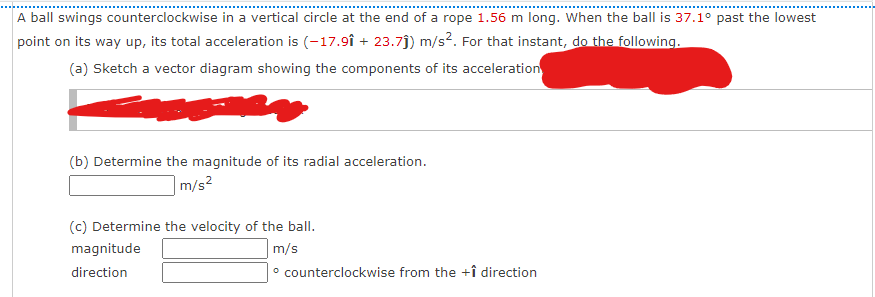A ball swings counterclockwise in a vertical circle at the end of a rope 1.56 m long. When the ball is 37.1° past the lowest point on its way up, its total acceleration is (-17.9î + 23.7ĵ) m/s². For that instant, do the following. (a) Sketch a vector diagram showing the components of its acceleration (b) Determine the magnitude of its radial acceleration. m/s2 |m/s² (c) Determine the velocity of the ball. magnitude m/s direction ° counterclockwise from the +î direction
A ball swings counterclockwise in a vertical circle at the end of a rope 1.56 m long. When the ball is 37.1° past the lowest point on its way up, its total acceleration is (-17.9î + 23.7ĵ) m/s². For that instant, do the following. (a) Sketch a vector diagram showing the components of its acceleration (b) Determine the magnitude of its radial acceleration. m/s2 |m/s² (c) Determine the velocity of the ball. magnitude m/s direction ° counterclockwise from the +î direction
Related questions
Question

Transcribed Image Text:A ball swings counterclockwise in a vertical circle at the end of a rope 1.56 m long. When the ball is 37.1° past the lowest
point on its way up, its total acceleration is (-17.9î + 23.7j) m/s2. For that instant, do the following.
(a) Sketch a vector diagram showing the components of its acceleration
(b) Determine the magnitude of its radial acceleration.
m/s?
(c) Determine the velocity of the ball.
magnitude
m/s
direction
° counterclockwise from the +î direction
Expert Solution
This question has been solved!
Explore an expertly crafted, step-by-step solution for a thorough understanding of key concepts.
This is a popular solution!
Trending now
This is a popular solution!
Step by step
Solved in 3 steps with 1 images
